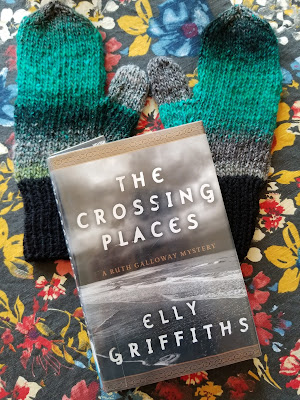The World's Simplest Mittens and the Crossing Places
The knitting: mittens
The novel: The Crossing Places, by Elly Griffiths
So! The mittens! Pattern is The World's Simplest Mittens by Tin Can Knits and the yarn is Noro Silk Garden that I scooped up in a grab bag in Yarniverse a couple of years ago with some Patons Classic Wool Worsted scraps. I've tried to knit the Noro into a couple of different hats and wasn't feeling the results, but I was able to work up these mittens in a just a few days and I'm delighted.
They're a birthday gift for a friend who really enjoys knitted gifts. There's something about mittens that is so fun. If I didn't have to mess with the thumb parts, I think I would like knitting mittens more than hats. This pattern calls for long cuffs, so I'm glad I used the Patons for that because the hands and thumbs used up around 3/4 of the skein. This is a fun little pattern and I'm happy with how this turned out. I think my friend will like these and I really need to get these to her before too much more time passes.
On to the novel: The Crossing Places: A Ruth Galloway Mystery. I love the Ruth Galloway mysteries. They remind me a fair amount of the DCI Karen Pirie series by Val McDermid. Dr. Ruth Galloway is a professor of archaeology who is asked by DCI Harry Nelson to help the police identify some bones that may be linked to a missing persons case. They aren't, but Ruth keeps getting pulled back into the case. The Ruth/Nelson pairing is a fairly fun one--Harry Nelson is probably the least-interesting character in these books, but what I like most about him is how clearly he sees Ruth as a person and how much he likes her.
It's easy to read about facets of Ruth's life--her weight, her cluttered cottage in the middle of nowhere, her rumpled clothing, her calm and methodical approach to research, her cats--through the lenses of other characters and see how the people in her life tend to underestimate her or see past her somehow. Her best friend is loyal, but withholds secrets because she doesn't think Ruth will understand. Her boss acknowledges her professional competency but is more interested in her ability to bring in funding to the university or to provide platforms for him to hold forth with his own expertise. One of my favorite parts of the book came when she was telling an ex-boyfriend about her work on the missing persons case, her dig, and everyone's opinions on the matters--and he asks her what she thinks. In the moment, she realizes her former tutor Erik, whom she still considers a mentor and friend, has never asked her what she thinks. It clarified a lot for me.
I didn't like Erik, who loves to hear himself talk. I didn't like Shona, the attention-seeking best friend with secrets and an exhausting personality even when she's a supportive friend. I didn't like Phil, whose best trait as a supervisor is that he gets out of Ruth's way. There are plenty of unlikable characters in the book, but they're interesting and they fit well within Ruth's world.
I have a policy about avoiding books and movies where children in peril are a major plot point, and I follow it pretty strictly. But there are plenty of children in peril in the series, and before the end of this book there are two bodies of little girls. Mothers grieve, people ask questions, it rains a lot. Characters are caught in a storm twice. Men (yes! plural!) are brought to their deaths by their own arrogance, but not before they ruin countless lives in innumerable, irreparable, immeasurable ways. At least one missing girl is brought back to her family, and that feels like a real win by the end of the story. Ruth and Nelson hook up even though he's married and has teenage daughters. This is a weird plot point that feels as shoehorned in as the way I just threw it out there in this paragraph, and I saw it coming even though I wished it wouldn't happen. But it does and it factors into this book, and all the others, in a pretty big way.
The book ends with Ruth pregnant, and working her writing about the bog body she has discovered. I don't understand a lot about archaeology, or eras (there are multiple references in the book to ignorant people who don't know the difference between the Bronze Age and the Iron Age that irritated me, but not enough to look them up and write them down), or the layout of marshes. But I do enjoy reading about them, and I enjoy protagonists who are women just doing their thing. The Ruth Galloway series is a nice treat if you like either of those things.





Comments
Post a Comment